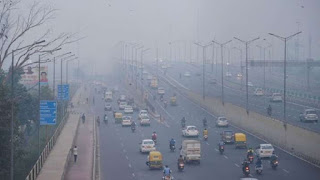ALARMING AIR POLLUTION IN DELHI
Bringing back horrifying memories of Hitler’s gas chamber
death camp, Delhi awoke on Monday (November 15, 2021) to find itself shrouded
in a toxic grey haze smog, with the air quality plummeting several steps below the safety level. The Air
Quality Index (AQI) reached the 490 mark on this day coming under the ‘Severe’
category condition. A blanket of thick smog enveloped the skies of the national
capital in the worst ever incidence of air pollution. The pollution level became so dire and menacing that it prompted a stern
warning issued from the Supreme Court directing the state and federal
governments to take "imminent and emergency" measures to tackle the situation.
Following this, the Delhi government
has to shut down schools until further notice, urge people to work from home, and ban non-essential trucks from entering the capital due to dangerous levels
of air pollution.
Air Quality Index of a locality is
generally measured by the presence of Suspended Particulate Matters (SPM) in
air. The average level of the deadliest particulate matter i.e. PM 2.5 in the
National Capital Region (NCR) reached over 400 mark (over 7 times the safe
limit) on that day. Inhaling this air has been equated by doctors with smoking
50 cigarettes a day. That’s why Delhi has been likened to Nazi Germany’s gas
chamber that killed millions of Jews mercilessly in its death trap.
New Delhi battles chronic winter smog
every year as a drop in the ambient temperature account for the accumulation of
deadly pollutants in the air mostly from coal-fired power plants outside the
city, fumes from vehicles, construction activity, and open burning of rubbish. One
of the key contributors to the air pollution in winter is the smoke from
farmers burning their crop residues after harvest in the neighbouring states. Also, the fireworks during the festival of Diwali,
which happens at the same time, only worsen the air quality. Low wind speed also plays a part as it traps the pollutants in the lower
atmosphere.
This year too, air quality in Delhi and
surrounding areas has deteriorated steadily since Diwali (November 4),
leaving the city covered with a thick fog of poisonous gases. The onset of winter
in the following days was dominated by cold dry air and ground-based inversion
with low wind speed conditions, which are responsible for increasing the concentration
of pollutants in the air.
An
AQI between 0-50 is considered "Good", 51-100
"Satisfactory", 101-200 "Moderate", 201-300 "Poor",
301-400 "Very poor", 401-500 "Severe" and above 500 is
"Severe-plus emergency" category. Delhi's AQI, on Monday (15th
November), stood at the ‘Severe’ category condition and inching alarmingly towards the ‘Severe-plus emergency’ category. The situation is expected to deteriorate further
due to high humidity and calm surface wind speeds affecting the dispersion of
pollutants. At this mark of air quality, the quantum of pollution has reached a
critical level and the air is highly unhealthy. Elderly individuals, in
particular, can feel its immediate effects and are at risk in falling sick to
various respiratory tract diseases like pneumonia, asthma, and even lungs cancer.
Even healthy people may show symptoms for short exposures.
As per a study carried out by the
World Health Organization (WHO), among the 1600 cities of the world, Delhi is
one of the worst cities in terms of air pollution and according to one
estimate, air pollution alone accounts for the death of nearly 10,500 people in
Delhi every year on an average. According to one study, Delhi citizens would
live on average an extra nine years if Delhi met WHO air quality standards. A Lancet report in 2020 said almost 17,500 people died in
Delhi in 2019 alone because of air pollution. The rising air pollution level
has significantly increased lungs related ailments among Delhi's children and
women. The dense smog in Delhi during the winter season results in major air
and rail traffic disruptions every year due to poor visibility conditions. According
to Indian Meteorological Department, the average maximum temperature in Delhi
during winters has declined noticeably since 1998 due to the upsurge in air
pollution.
Delhi's population continues to grow
rapidly unabated as thousands of migrants arrive in the capital city each year
in search of jobs for better opportunities. Dust-generating construction sites,
industrial emissions as well as the proliferation of coal-fired power plants
contribute to the increasing deterioration of air quality in Delhi. Car sales
have also been soaring as the income of people has been steadily rising with
improvements in living standards. This is evident from the fact that nearly 10
million vehicles used to jostle for space on the roads of Delhi every day while thousands of diesel-guzzling trucks rumble
across the capital every night bringing in essential commodities from
neighboring states.
As
a long-term goal, Delhi must find ways to restrict the construction activities
in and around the city. Industries located in the region should be relocated to
safer places. Automobile exhausts should be periodically monitored for the emission
of harmful gases. Farmers in the neighbouring states must be educated and
technologically equipped to dispose of their post-harvest crop residues in the
most eco-friendly manner. All outdated diesel engines like pumps and generator
sets in the region that spew harmful gases
must be replaced with low emission systems satisfying statutory environmental standards.
Strict rules should be imposed for proper dumping and disposal of solid wastes since their unregulated burning results in the pile-up of smoke and particulate
matter in concentrated form at one place.
Nikunja Bihari Sahu
Education Officer
Regional Science Centre
Bhopal
Phone : 8018708858




Comments
Post a Comment